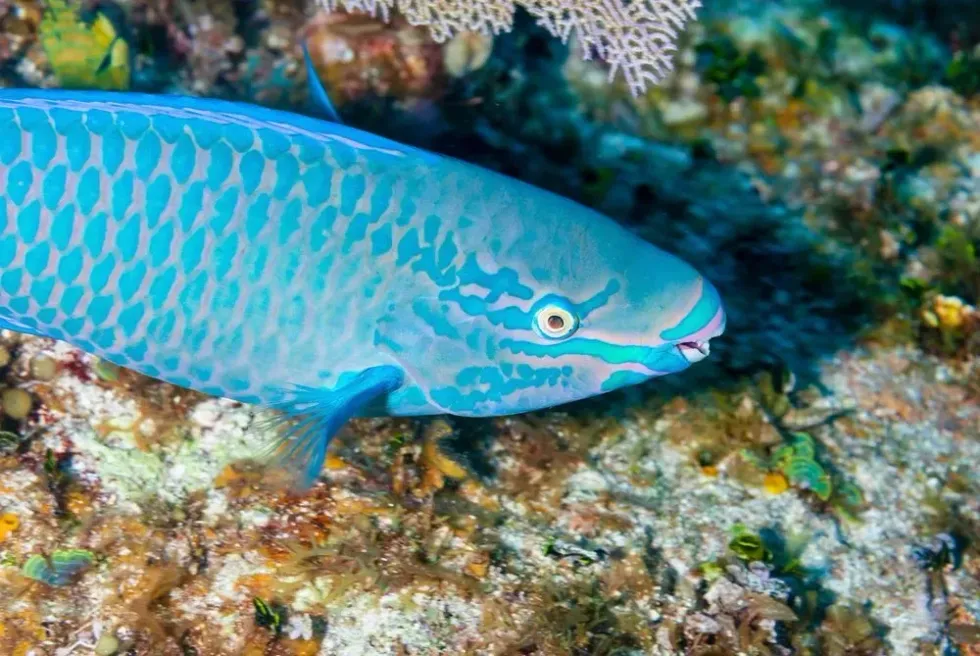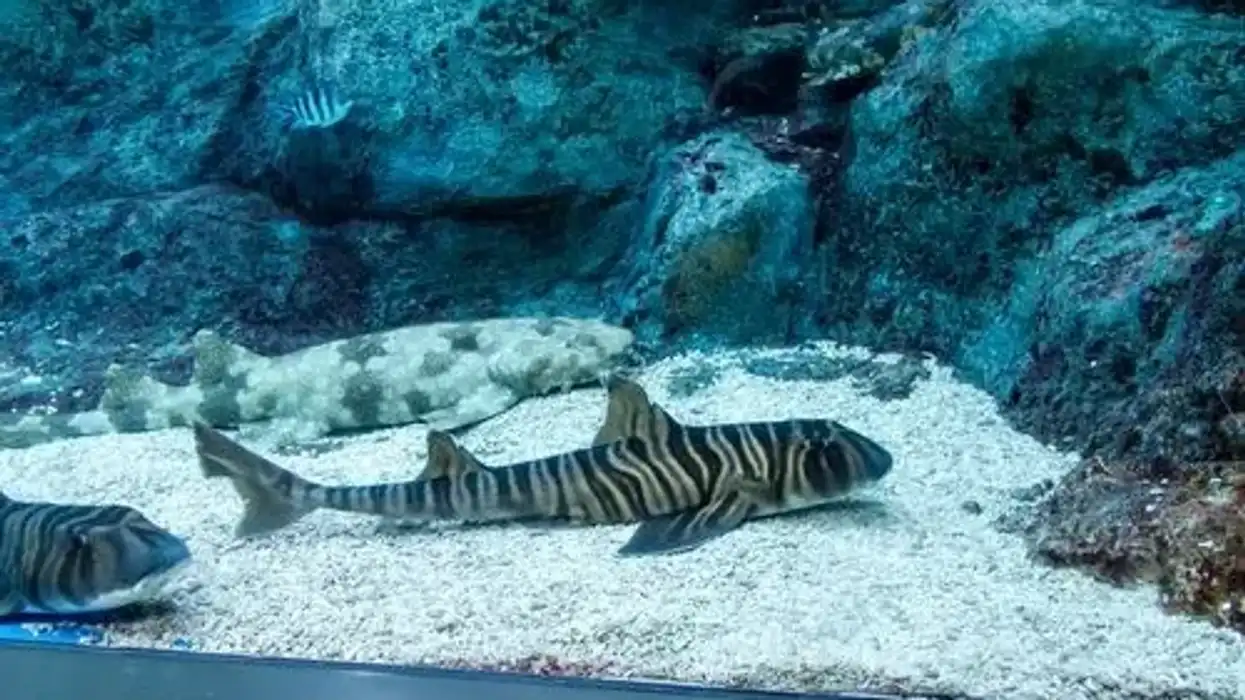The striped parrotfish is a type of ray-finned parrotfish belonging to the Actinopterygii class. They are the most common parrotfish found in the Caribbean and their distribution can mainly be found in North Atlantic waters around the Bahamas, Bermuda, Florida, and Venezuela.
These marine reef fishes tend to travel in schools and get along well with fishes of other species. They live in and around coral reefs and beds among the seagrass, feeding on the algae which coat the corals.
Striped parrotfish can be differentiated from other parrotfish species by observing a range of various markings on their bodies, which tend to change along with age. Fishes in the terminal stage tend to be more brightly colored and larger than juveniles, and are also seen as more dominant.
To learn more about these cleaners of the reef, read on! For more relatable content, check out these pumpkinseed sunfish facts and Chinese paddlefish facts for kids.
Striped Parrotfish Interesting Facts
What type of animal is a striped parrotfish?
The striped parrotfish (Scarus iseri) is a type of parrotfish belonging to the genus Scarus.
What class of animal does the striped parrotfish belong to?
The striped parrotfish (Scarus iseri) belongs to the ray-finned fish class Actinopterygii and genus Scarus.
How many striped parrotfish are there in the world?
Determining the exact population of these fishes is quite difficult, as they live in large groups in coral reefs and often hide in underwater caves and crevices, making it impossible to note the existence of each individual. However, they are currently available in abundance in the wild, their IUCN Red List status being of Least Concern.
Where do striped parrotfish live?
Striped parrotfish (Scarus iseri) can be found in the western Atlantic ocean, ranging from the waters of Bermuda and the Bahamas and Florida to Venezuela in the Caribbean. It is the most common parrotfish species in the Caribbean.
What is a striped parrotfish's habitat?
Parrotfish are found in the Atlantic Ocean, in tropical waters. They mainly inhabit coral reefs, coexisting with marine reef species. They prefer living in rocky areas populated with seagrass and algae which they feed on, and in rare cases can be found in freshwater pools as well.
Who do striped parrotfish live with?
Smaller striped parrotfish can usually be found living in groups consisting of several females and a single male. The larger, more colorful fish pair up in order to breed. Outside of the breeding season, they are schooling fish and can be found in large groups around coral beds.
How long does a striped parrotfish live?
Striped parrotfish (Scarus iseri) have been observed to live for quite long in the wild, with their life cycle spanning eight years of age.
How do they reproduce?
This fish species breeds throughout the year. Striped parrotfish have two types of reproductive behavior.
The smaller fish usually form single male groups, with several smaller females. The females lay eggs over which the male then spawns, leaving the eggs to fertilize for about 25 hours until they hatch. Not enough data is available to know the number of eggs laid.
These fish can change their sex, and if the male passes away the biggest females of the group will change into males and continue to engage in the mating process. Larger and more colorful males are more territorial and pair up with a single female in order to breed and feed with.
What is their conservation status?
Striped parrotfish (Scarus iseri) are the most common species of parrotfish in the Caribbean and are currently listed as of Least Concern in the IUCN Red List. Fishing, climate change, pollution are some of the major dangers to the parrotfish population.
Striped Parrotfish Fun Facts
What do striped parrotfish look like?

These medium-sized, multicolored tropical fish are named after the beak-like plates in their mouth instead of teeth that resemble that of a parrot. They are iridescent, colorful fish covered with a variety of different colored stripes.
They have a white stripe above their gills, with a corresponding dark stripe below.
Their main bodies are interspaced with bright blue and pink stripes, with their tail fin being blue-green in color. Their dorsal fin is long and runs across their bodies, having pink, yellow, and orange stripes crossed with blue and green.
Their pectoral fins are blue with a single yellow stripe, and terminal phase male fish have a green stripe under the eye and have more orange and green in their coloring.
Their belly is a pale white-pink color. Their fins lack the borders which princess parrotfish, a species closely associated with the striped parrotfish have, making it possible to differentiate between them.
Fish in the initial phase and juvenile stage are much paler in color, having three dark stripes and two white stripes running along their body along with a yellow spot near the mouth.
How cute are they?
With their beautiful luminescent scales and mother of pearl coloring, these parrotfishes are stunning to look at and are a treat for the eyes.
How do they communicate?
Like all other fish, tropical striped parrotfish communicate through a wide range of sounds, colors, and secretions to communicate. Male parrotfish are known to be more aggressive or dominant when they are dark in color, which warns smaller males to keep away.
These fish emit a thick, smelly mucus-like substance at night to deter predators which mostly hunt by smell, making sure that they do not end up as prey while they sleep.
How big are striped parrotfish?
Striped parrotfish are medium-sized fish and have been observed to weigh in between 7.1-13.8 in (18-35 cm) in length. They are two times smaller than blue parrotfish and queen parrotfish.
How fast can a striped parrotfish swim?
Though the exact speed of the striped parrotfish is unknown, it has been observed to be a quite fast swimmer. It uses its dorsal and tail fins to provide a short burst of speed, which it uses to weave its way through the coral reefs and catch ocean currents.
How much does a striped parrotfish weigh?
Unfortunately, there is currently no accurate information available on how much these fish weigh.
What are the male and female names of the species?
There are no specific names for either males or females of this fish species. Striped parrotfish do not conform to one specific sex and can change their sex according to their needs.
What would you call a baby striped parrotfish?
Baby striped parrotfish are known as fingerlings or fry.
What do they eat?
Striped parrotfish use their beak-like mouth plates in order to scrape off algae from dead corals and rocks, which forms a major part of their diet. They are herbivorous in nature, and this algae is their sole means of nutrition.
This action causes the outer layer of the corals to grind up and form sand, which drifts away to the shore.
Are they dangerous?
No, parrotfish are not dangerous and can also be consumed by humans. They are eaten in many parts of the world. The striped parrotfish is not a poisonous species of fish and can be consumed safely by humans. Parrotfish meat is known to be very soft and sweet owing to its diet of algae and corals.
Would they make a good pet?
Most parrotfish are not suited to be pets, due to their particular feeding habits, which cannot be recreated well in captivity. Parrotfish mostly feed off of algae on rocks and dead corals, without which they are unable to survive in captivity.
Despite this, they are quite docile in behavior and get along well with other species of fish, meaning that they would have made good tank mates.
Did you know...
Parrotfish are very helpful to coral reefs, and their feeding habits allow corals to grow without being completely covered and smothered by the growing algae. This promotes the healthy growth of new coral and the breakdown of the dead ones to prevent overcrowding.
They are closely associated with the princess parrotfish, a similar-looking species, who also live in coral reefs and consume algae. The two species can be differentiated by the lack of borders on the striped parrotfish's tail.
Though other parrotfishes, like the blue parrotfish, contain toxins that can prove harmful to humans when consumed, the striped parrotfish is safe to eat and is also known to be quite tasty.
Juvenile parrotfish have pale markings and color, their scales becoming darker as they advance in their life cycle.
The striped parrotfish family contains over 90 species of parrotfish!
Do parrotfish eat coral?
Parrotfish are known to scrape away at algae on the surfaces of rocks and dead corals. They do this with the help of two plate-like structures resembling a parrot's beak on the inside of their mouth, which causes the breakdown of the corals.
They do not directly eat the corals but are responsible for their breakdown which helps in the formation of sand and prevents coral overgrowth on the reefs. They indirectly consume bits of coral along with the algae they feed on.
Why is it called striped parrotfish?
Striped parrotfish are a type of parrotfish, which are named after their hard, beak-like mouths instead of teeth which help to grind up algae and coral. These colorful fish are covered in multicolored iridescent stripes of blue, orange, green, and pink, hence they have been given the name striped parrotfish.
Here at Kidadl, we have carefully created lots of interesting family-friendly animal facts for everyone to discover! Learn more about some other fish from our black dragonfish surprising facts and green sunfish fun facts pages.
You can even occupy yourself at home by coloring in one of our free printable striped parrotfish coloring pages.









